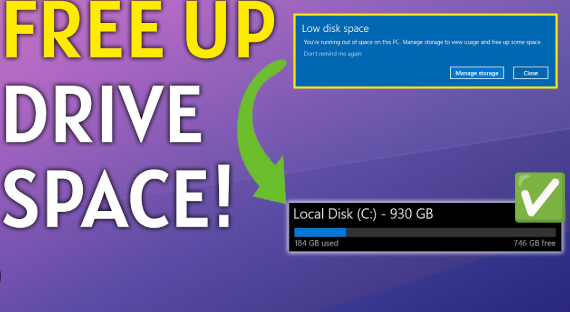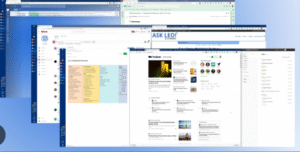
Running out of space on your Windows hard drive can cause your PC to slow down, reduce performance, and even crash programs. Whether you use Windows 10 or Windows 11, freeing up space not only improves performance but also gives you more room for your files, apps, and updates.
In this guide, we’ll walk through proven methods to free up disk space on your Windows PC, from using built-in tools to advanced techniques — all without harming your system.
Why Is Your Hard Drive Full?
Before diving into solutions, it’s helpful to understand what consumes space:
-
System and temporary files
-
Old Windows updates
-
Installed programs and apps
-
Downloads and unused files
-
Cached files and browser data
-
Large videos, pictures, and documents
-
Hidden files like system restore points
Knowing this helps you target the right areas for cleanup.
1. Use Storage Sense
Storage Sense is a built-in Windows tool that automatically removes unnecessary files.
How to Use Storage Sense:
-
Go to Settings > System > Storage.
-
Click on Storage Sense or turn it ON.
-
Click Configure Storage Sense or run it now.
-
Choose when and what to delete (temporary files, downloads, recycle bin).
-
Click Clean now to perform a manual cleanup.
Storage Sense is an excellent first step for freeing up space without manual effort.
2. Delete Temporary Files
Temporary files are generated during updates, browsing, installations, and program usage. They pile up fast.
How to Manually Delete Temp Files:
-
Press
Windows + R, typetemp, and press Enter. -
Delete all files in the folder.
-
Repeat with
%temp%andprefetch.
Tip: These folders may contain hundreds of MBs of unneeded files.
3. Clean the Recycle Bin
Deleted files aren’t gone — they stay in the Recycle Bin, consuming space.
How to Empty Recycle Bin:
-
Right-click the Recycle Bin icon on your desktop.
-
Select Empty Recycle Bin.
To automate this:
-
Open Settings > System > Storage.
-
Use Storage Sense to auto-delete Recycle Bin files older than 30 days.
4. Uninstall Unused Apps and Programs
Old or unused apps and games can take up several GBs.
Steps to Uninstall Programs:
-
Go to Settings > Apps > Installed apps.
-
Sort by Size to see what takes up the most space.
-
Click Uninstall on programs you don’t need.
Consider removing trial software, outdated drivers, or bloatware.
5. Use Disk Cleanup Utility
Disk Cleanup is a legacy tool that still works great in Windows.
How to Run Disk Cleanup:
-
Press
Start, search for Disk Cleanup. -
Select your main drive (usually C:).
-
Check options like:
-
Temporary Internet Files
-
Windows Update Cleanup
-
Delivery Optimization Files
-
Recycle Bin
-
-
Click OK > Delete Files.
To clean system files:
-
Click Clean up system files in the tool.
6. Remove Old Windows Update Files
After a big update, Windows keeps backup files to revert changes. These can be safely removed if your PC is running smoothly.
Steps:
-
Open Disk Cleanup > Clean up system files.
-
Check Previous Windows Installation(s) and Windows Update Cleanup.
-
Click OK.
This can free 5–20 GB of space!
7. Move Files to External Storage
If your drive is nearly full, moving large files to an external drive is smart.
Suggested Items to Move:
-
Videos and Movies
-
Photos
-
Music and Podcasts
-
Large installers or archives
Use a reliable USB flash drive, external HDD/SSD, or cloud storage as a backup.
8. Store Files in the Cloud
Windows offers built-in cloud storage via OneDrive.
How to Use OneDrive:
-
Set up OneDrive from the system tray.
-
Move non-essential files (documents, photos) to OneDrive.
-
In OneDrive settings, enable Files On-Demand:
-
This allows files to appear locally but only download when needed.
-
You get 5 GB free, with upgrade options.
9. Analyze Disk Space Usage with Tools
Sometimes, a few large files eat up space. Use visual tools to track them down.
Recommended Tools:
-
WinDirStat (free): Color-coded map of space usage.
-
TreeSize Free: Shows which folders use the most space.
Once identified, you can delete or move large files safely.
10. Delete System Restore Points
System restore points are snapshots of your system. Useful, but they can take up tens of gigabytes.
How to Remove:
-
Open Control Panel > System > System Protection.
-
Select your system drive > Configure.
-
Click Delete to remove restore points.
You can also reduce the space allocated to future restore points.
11. Disable Hibernation
Hibernation uses a hidden file (hiberfil.sys) equal to your RAM size — often 8–16 GB or more.
Disable It via Command:
-
Open Command Prompt as Administrator.
-
Type:
-
Press Enter.
This removes the file and disables hibernate mode.
12. Compress Windows Installation Files
Windows lets you compress the OS drive to save space without deleting anything.
Enable Compact OS:
-
Open Command Prompt as Admin.
-
Type:
-
Press Enter.
This can free up 1–3 GB on average.
13. Manage Downloads Folder
The Downloads folder can become a graveyard of unused files, installers, and duplicates.
Tips:
-
Sort by size or date.
-
Delete old .zip/.exe/.mp4 files you don’t need.
-
Set Storage Sense to auto-delete old downloads.
14. Turn Off Delivery Optimization Cache
Windows sometimes uses your bandwidth and stores updates to share with other devices.
How to Clear It:
-
Go to Settings > Update & Security > Delivery Optimization.
-
Click Advanced Options.
-
Set Cache Size to minimum or turn off the feature.
-
Use Disk Cleanup to delete cached files.
15. Use Third-Party Cleaners Cautiously
Tools like CCleaner can clean temporary files, browser caches, and startup items.
⚠️ Use with care. Always backup important files and avoid registry cleaning unless you’re advanced.
16. Delete Duplicate Files
Over time, duplicates build up—especially photos, videos, and downloads.
Tools for Finding Duplicates:
-
Duplicate Cleaner Free
-
dupeGuru
-
Auslogics Duplicate File Finder
Review results before deleting to avoid losing valuable files.
17. Archive Old Data
If you don’t want to delete files but don’t need them often:
-
Compress them into .zip or .rar files.
-
Store them in an external drive or cloud archive.
This reduces their size while keeping them accessible.
18. Upgrade Your Drive (Bonus Tip)
If your hard drive is old or small (like 128GB), upgrading to a larger SSD or adding a secondary drive is a long-term solution.
Benefits:
-
More space
-
Faster performance
-
Future-proofing your system
You can clone your existing drive or do a clean Windows installation.
Final Words: Keep It Clean Regularly
Freeing up space is not a one-time fix. Make it a habit to check and clean your disk monthly. Enable Storage Sense, review Downloads, and keep backups off your local drive.
Here’s a quick monthly maintenance checklist:
| Task | Frequency |
|---|---|
| Run Storage Sense | Monthly |
| Clean Recycle Bin | Weekly |
| Review Downloads | Monthly |
| Uninstall Unused Apps | Bi-Monthly |
| Clear Temp Files | Monthly |
| Analyze Large Files | Quarterly |
Conclusion
With these 18 practical tips, you can reclaim tens or even hundreds of gigabytes of space on your Windows PC. From built-in tools like Disk Cleanup and Storage Sense to cloud solutions and external drives, managing storage is easier than ever.
Whether you’re prepping for a big Windows update or just want a faster PC, regular space management is essential. Implement these steps, and your system will run smoother, faster, and with room to breathe.







